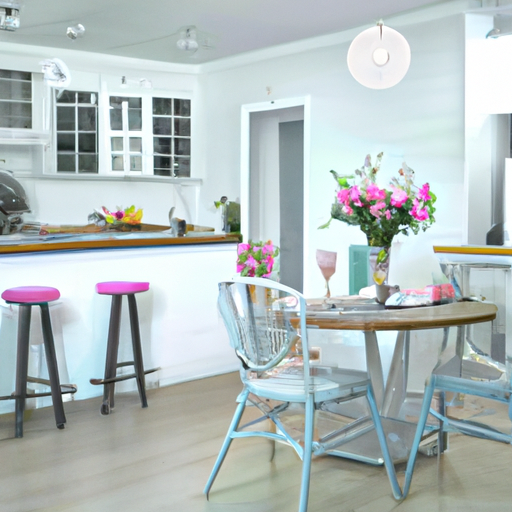Integrating Personal Interests into Your Home Design
Designing a home that reflects your lifestyle is an essential aspect of creating a living space that is not only functional but also a true representation of your personality and interests. Integrating personal interests into your home design allows you to create a unique and inviting environment that showcases your passions and hobbies. This article will discuss various ways to incorporate your interests into your home design, ensuring that your living space is a true reflection of your lifestyle.
One of the first steps in integrating personal interests into your home design is to identify the activities and hobbies that are most important to you. This may include sports, music, art, travel, or any other pursuits that you are passionate about. Once you have identified your interests, you can begin to brainstorm ways to incorporate these elements into your home design.
For example, if you are an avid reader, you may want to create a cozy reading nook in your living room or bedroom. This can be achieved by incorporating comfortable seating, ample lighting, and built-in bookshelves to house your collection of books. Alternatively, if you are a musician, you may want to designate a specific area of your home as a music room, complete with soundproofing, instruments, and a comfortable space for practicing and performing.
In addition to creating dedicated spaces for your hobbies and interests, you can also integrate these elements into the overall design of your home. For instance, if you are a sports enthusiast, you may want to incorporate sports memorabilia or artwork into your home décor. This can be done through the use of framed jerseys, vintage sports posters, or even a display case for your collection of sports memorabilia.
Similarly, if you are passionate about travel, you may want to incorporate elements from your favorite destinations into your home design. This can be achieved through the use of artwork, textiles, and decorative items that are representative of the cultures and locations you have visited. For example, you may choose to display a collection of souvenirs from your travels on a dedicated shelf or incorporate a beautiful tapestry from your favorite destination as a focal point in your living room.
Another important aspect of designing a home that reflects your lifestyle is to consider the needs and preferences of your family members. If you have children, you may want to create a dedicated playroom or incorporate kid-friendly elements into your home design, such as built-in storage for toys and games. Similarly, if you have pets, you may want to consider pet-friendly flooring options and designate specific areas of your home for your furry friends to enjoy.
When integrating personal interests into your home design, it is essential to strike a balance between showcasing your passions and maintaining a cohesive and functional living space. This can be achieved by carefully selecting the elements that best represent your interests and incorporating them into your home design in a way that complements the overall aesthetic of your living space.
In conclusion, designing a home that reflects your lifestyle is an important aspect of creating a living space that is both functional and representative of your personality and interests. By identifying your passions and hobbies, creating dedicated spaces for these pursuits, and incorporating elements of your interests into your home décor, you can create a unique and inviting environment that truly reflects your lifestyle. Remember to consider the needs and preferences of your family members and strive for a balance between showcasing your interests and maintaining a cohesive and functional living space.
Creating Functional Spaces for Your Daily Activities

Designing a home that reflects your lifestyle is an essential aspect of creating a comfortable and functional living space. A well-designed home should not only be aesthetically pleasing but also cater to the specific needs and preferences of its occupants. This involves considering various factors such as the size of the family, hobbies, work habits, and socializing preferences. By creating functional spaces for your daily activities, you can ensure that your home is tailored to your unique lifestyle, making it a true reflection of who you are.
One of the first steps in designing a home that reflects your lifestyle is to identify the activities that you and your family engage in regularly. This may include cooking, dining, working, exercising, or entertaining guests. Once you have a clear understanding of your daily routines, you can begin to allocate space for each activity and design the layout accordingly. For instance, if you enjoy cooking and hosting dinner parties, you may want to prioritize a spacious and well-equipped kitchen and dining area. On the other hand, if you work from home, a dedicated home office with ample storage and a comfortable workspace would be essential.
In addition to considering the activities that take place within your home, it is also important to think about how you interact with the surrounding environment. For example, if you enjoy spending time outdoors, you may want to incorporate features such as large windows, balconies, or a patio to create a seamless connection between your indoor and outdoor living spaces. This not only enhances the overall aesthetic appeal of your home but also allows you to enjoy the benefits of natural light and fresh air.
Another crucial aspect of designing a home that reflects your lifestyle is to ensure that the space is adaptable and flexible. As your needs and preferences evolve over time, your home should be able to accommodate these changes without requiring significant alterations. This can be achieved by incorporating multi-functional spaces and furniture that can be easily reconfigured or repurposed. For example, a spare bedroom can double as a home office or a playroom, while a modular sofa can be rearranged to create different seating arrangements depending on the occasion.
In addition to functionality, the materials and finishes used in your home should also reflect your personal style and preferences. This can be achieved by selecting a cohesive color palette and incorporating textures and patterns that resonate with your aesthetic sensibilities. For instance, if you prefer a minimalist and contemporary look, you may opt for sleek surfaces, neutral tones, and clean lines. On the other hand, if you are drawn to a more traditional and cozy ambiance, you may choose warm colors, rich fabrics, and ornate details.
Lastly, it is essential to consider the practical aspects of maintaining your home when designing a space that reflects your lifestyle. This includes selecting durable materials that can withstand daily wear and tear, as well as incorporating storage solutions that help keep your living spaces organized and clutter-free. By addressing these practical concerns, you can ensure that your home remains functional and visually appealing over time.
In conclusion, designing a home that reflects your lifestyle involves a careful consideration of your daily activities, personal preferences, and practical needs. By creating functional spaces that cater to your unique requirements, you can ensure that your living environment is not only aesthetically pleasing but also tailored to your specific way of life. This, in turn, allows you to enjoy a comfortable and harmonious living space that truly feels like home.
Selecting Materials and Colors that Represent Your Personality
Designing a home that reflects your lifestyle is an exciting and rewarding process. It allows you to create a space that is uniquely yours, showcasing your personality, interests, and values. One of the most important aspects of this process is selecting materials and colors that represent your personality. By carefully considering the various options available, you can create a cohesive and harmonious design that truly reflects who you are.
When it comes to selecting materials for your home, it’s essential to consider both the aesthetic and functional aspects. The materials you choose should not only look good but also be durable and easy to maintain. This is particularly important in high-traffic areas such as the kitchen and bathroom, where wear and tear can quickly take its toll. Some popular materials for these spaces include natural stone, porcelain, and ceramic tiles, as well as engineered quartz and solid surface countertops. These materials offer a wide range of colors and textures, allowing you to create a look that is both stylish and practical.
In addition to the materials themselves, it’s also important to consider the finishes and details that will help to bring your design to life. For example, you might choose to incorporate decorative moldings, custom cabinetry, or unique hardware to add a touch of personality to your space. These elements can help to create a sense of cohesion and harmony throughout your home, ensuring that each room feels like a natural extension of the next.
When it comes to selecting colors for your home, it’s important to think about the overall mood and atmosphere you want to create. This will largely depend on your personal preferences and the type of lifestyle you lead. For example, if you enjoy a calm and tranquil environment, you might opt for a palette of soft, muted tones such as pale blues, greens, and grays. On the other hand, if you prefer a more vibrant and energetic atmosphere, you might choose bold, saturated colors like reds, oranges, and yellows.
It’s also important to consider the impact of natural light on your color choices. Rooms that receive a lot of sunlight may appear brighter and more spacious, while those with limited natural light may feel darker and more enclosed. To counteract this effect, you might choose to use lighter colors in rooms with less natural light and darker colors in sunnier spaces. This can help to create a sense of balance and harmony throughout your home.
Another key factor to consider when selecting colors is the relationship between different hues. By using a color wheel, you can identify complementary, analogous, and triadic color schemes that will help to create a cohesive and harmonious design. For example, you might choose to use a combination of blue and orange, which are complementary colors, or a palette of green, yellow, and blue, which are analogous colors. By carefully considering these relationships, you can create a visually appealing and well-balanced design.
In conclusion, selecting materials and colors that represent your personality is an essential part of designing a home that reflects your lifestyle. By carefully considering the various options available and taking into account factors such as durability, maintenance, natural light, and color relationships, you can create a space that is both beautiful and functional. Ultimately, the key to success lies in finding the perfect balance between aesthetics and practicality, ensuring that your home is not only a reflection of who you are but also a comfortable and inviting space in which to live.
Q&A
Question 1: What are the key elements to consider when designing a home that reflects my lifestyle?
Answer: The key elements to consider when designing a home that reflects your lifestyle are: space planning, functionality, personal style, comfort, and budget.
Question 2: How can I incorporate my hobbies and interests into my home design?
Answer: To incorporate your hobbies and interests into your home design, dedicate specific areas or rooms for those activities, display related collections or artwork, and choose furniture and accessories that support and enhance those interests.
Question 3: How can I ensure my home design remains flexible for future lifestyle changes?
Answer: To ensure your home design remains flexible for future lifestyle changes, opt for open floor plans, multi-functional spaces, adaptable furniture, and neutral color schemes that can easily be updated with new accents and accessories.
Conclusion
In conclusion, designing a home that reflects your lifestyle is essential for creating a living space that is both functional and personal. By considering your daily routines, hobbies, and design preferences, you can create a home that not only meets your practical needs but also showcases your unique personality and style.


